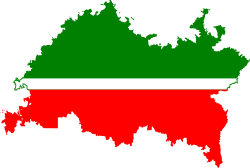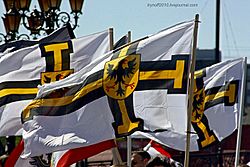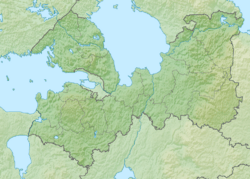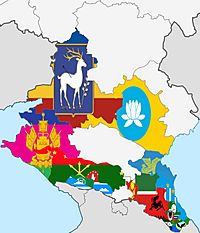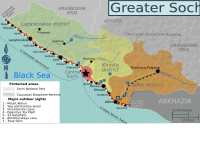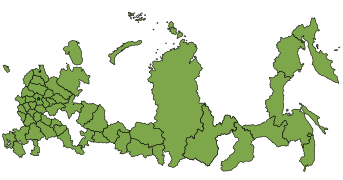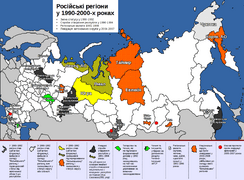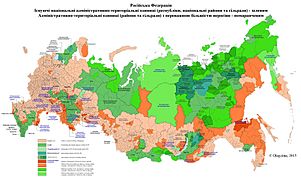Secession in Russia facts for kids
Secession in Russia is about different groups and regions in Russia that want to separate and become independent countries, or at least have more control over their own areas. It's like a part of a team wanting to form its own team.
These movements often happen because people in certain regions have different cultures, languages, or histories from the main Russian population. They might feel that their unique identity is not fully recognized or that their region's needs are not met by the central government.
Contents
Summary of Movements
This table lists some of the areas and groups that have movements wanting more independence or to separate from Russia. The population numbers are just for your information.
| Number | Land | Capital | Area | Population | Ethnic Group | Main Political Party |
|---|---|---|---|---|---|---|
| All of Asian Russia | ||||||
| 1 | Novosibirsk | 13,100,000 | 40,000,000 | Sibiryak people | Siberian regionalism | |
| Far Eastern Federal District of Asian Russia | ||||||
| 2 | Yakutsk | 3,083,523 | 1,000,000 | Yakut people | Sakha-Amuk | |
| 3 | Chita | 1,900,000 | 3,000,000 | Nanai people | Alliance of the Pacific Peoples | |
| 4 | Anadyr | 737,700 | 50,000 | Chukchi people | ||
| 5 | Ulan-Ude | 351,300 | 1,000,000 | Buryat people | All-Buryat Association | |
| 6 | Palana | 292,600 | 15,000 | Koryak people | ||
| 7 | Evensk | 102,000 | 3,000 | Even people | ||
| 8 | Birobidzhan | 36,000 | 150,000 | Jewish people | ||
| 9 | Troitskoye | 27,644 | 15,000 | Nanai people | Nanai People's Platform | |
| Siberian Federal District of Asian Russia | ||||||
| 10 | Dudinka | 879,929 | 40,000 | Dolgan people | ||
| 11 | Tura | 763,197 | 20,000 | Evenk people | ||
| 12 | Kyzyl | 170,500 | 300,000 | Tuvan people | People's Party of Sovereign Tuva | |
| 13 | Krasnoselkup | 106,270 | 6,000 | Selkup people | ||
| 14 | Gorno-Altaysk | 92,600 | 220,000 | Altai people | Altai-Sayun United Movement | |
| 15 | Abakan | 61,900 | 550,000 | Khakas people | ||
| 16 | Tashtagol | 25,000 | 15,000 | Shor people | ||
| 17 | Ust-Ordynsky | 22,138 | 150,000 | Buryat people | All-Buryat Association | |
| 18 | Aginskoye | 19,600 | 80,000 | Buryat people | All-Buryat Association | |
| Ural Federal District of Asian Russia | ||||||
| 19 | Salekhard | 750,300 | 500,000 | Nenets people | Yamal for Future Generations | |
| 20 | Khanty-Mansiysk | 534,800 | 1,500,000 | Finno-Ugric people | Association to Save Yurga | |
| Ural Federal District of European Russia | ||||||
| 21 | Yekaterinburg | 194,800 | 4,300,000 | Russian people | Ural Democratic Foundation | |
| Volga Federal District of European Russia | ||||||
| 22 | Kazan | 321,400 | 11,000,000 | Volga people | Free Idel-Ural | |
| 23 | Ufa | 143,600 | 4,050,000 | Bashkir people | The Heavenly Wolf | |
| 24 | Kazan | 68,000 | 4,000,000 | Tatar people | All-Tatar Public Center | |
| 25 | Izhevsk | 42,100 | 1,500,000 | Udmurt people | Udmurt Republican National Party | |
| 26 | Saransk | 26,200 | 800,000 | Mordvin people | Democracy and Independence Mordvin Front | |
| 27 | Yoshkar-Ola | 23,200 | 700,000 | Mari people | Mari Ushem | |
| 28 | Cheboksary | 18,300 | 1,250,000 | Chuvash people | Chuvash National Movement | |
| Northwestern Federal District of European Russia | ||||||
| 29 | Syktyvkar | 415,900 | 850,000 | Komi people | Komi People's Congress | |
| 30 | Naryan-Mar | 176,700 | 45,000 | Nenets people | Nenet National Movement | |
| 31 | Petrozavodsk | 172,400 | 600,000 | Karelian people | ||
| 32 | Kaliningrad | 84,500 | 1,800,000 | Russian people | ||
| 33 | Kudymkar | 32,770 | 120,000 | Komi people | Komi People's Congress | |
| 34 | Leningrad | 15,100 | 1,000,000 | Ingrian people | Free Ingria | |
| Southern Federal District of European Russia | ||||||
| 35 | Rostov | 100,800 | 4,200,000 | Donian people | Free Cossack Movement (Rostov Oblast) | |
| 36 | Krasnodar | 76,000 | 5,300,000 | Kubanian people | Free Cossack Movement (Krasnodar Krai) | |
| 37 | Elista | 76,000 | 300,000 | Kalmyk people | ||
| North Caucasian Federal District of European Russia | ||||||
| 38 | Sochi | 50,000 | 1,000,000 | Circassian people | Circassian nationalism | |
| 39 | Grozny | 17,300 | 1,500,000 | Chechen people | Chechen Republic of Ichkeria | |
| 40 | Derbent | 10,000 | 800,000 | Lezgin people | Lezgin nationalism | |
| 41 | Karachayevsk | 10,000 | 300,000 | Turkic people | Balkar and Karachay nationalism | |
| 42 | Magas | 3,000 | 500,000 | Ingush people | Ingush People Council | |
| 43 | Rutul | 2,170 | 20,000 | Rutul people | Rutul National Revival Front | |
| 44 | Adlersky | 2,000 | 50,000 | Abkhaz people | World Congress of Abkhaz-Abazin people | |
| 45 | Kumukh | 1,500 | 200,000 | Lak people | Lak National Council | |
| 46 | Khuchni | 1,400 | 75,000 | Tabasaran people | Tabasaran National Movement | |
| 47 | Khunzakh | Unknown | 850,000 | Avar people | Avar National Union | |
| 48 | Levashi | Unknown | 500,000 | Dargin people | Free Society of Dargo | |
| 49 | Tarki | Unknown | 500,000 | Kumyk people | Tenglik | |
| 50 | Erken | Unknown | 100,000 | Nogai people | Association of Nogais of Dagestan | |
| 51 | Aguldere | Unknown | 25,000 | Aghul people | Agul Gelinbatan | |
| Total | 15,000,000 | 80,000,000 | Ethnic Groups | Secession in Russia | ||
| Total | Moscow | 17,100,000 | 150,000,000 | Russian people | Russian nationalism | |
Asian Russia
Many parts of Asian Russia have groups that want more control over their own areas or even full independence. These regions are often home to different indigenous groups with their own unique cultures and languages.
Siberian Republic
The idea of a Siberian Republic is one of the largest movements. It aims to create an independent state in Siberia, a huge region known for its vast lands and resources. People who support this idea are sometimes called Siberian regionalists. They believe Siberia should have more power to manage its own affairs.
Far Eastern Federal District
The Far Eastern Federal District is another area with several movements.
- The Sakha Republic (also known as Yakutia) is home to the Yakut people. They have groups like Sakha-Amuk that support more self-rule.
- The Far Eastern Republic was a real country for a short time in the early 1900s. Today, some groups want to bring back a similar independent state in the Far East.
- In Chukotka, the Chukchi people have movements like the Chukchi National Revival Movement that want more independence.
- Buryatia is where the Buryat people live. They have organizations like the All-Buryat Association that work for their cultural and political rights.
Siberian Federal District
This district also has several groups seeking more autonomy:
- Tuva is a region where the Tuvan people have political parties like the People's Party of Sovereign Tuva, which aims for greater self-governance.
- The Altai Republic is home to the Altai people, who have movements like the Altai-Sayun United Movement working for their interests.
- Other areas like Evenkia (for the Evenk people) and Khakassia (for the Khakas) also have groups that want more control over their lands and cultures.
Ural Federal District (Asian Part)
In the Asian part of the Ural Federal District, groups like the Nenets people in Yamalia and the Khanty people and Mansi people in Khanty-Mansi Autonomous Okrug are working to protect their traditional ways of life and gain more say in their regions.
European Russia
Many regions in European Russia also have groups that want more independence or greater self-rule. These movements are often linked to the unique ethnic groups and historical events in these areas.
Ural Federal District (European Part)
- The Ural Republic is a proposed state in the Sverdlovsk Oblast. Some people in this area, mostly Russian people, want more local control and a stronger regional government.
Volga Federal District
The Volga Federal District is a diverse area with many different ethnic groups.
- The Idel-Ural movement aims to unite several groups in the Volga region, including Bashkirs, Tatars, and Udmurts, into a single independent state. The Free Idel-Ural group is a key supporter of this idea.
- Tatarstan is a republic where the Tatar people have a strong sense of identity. Groups like the All-Tatar Public Center work to promote Tatar culture and political rights.
- Bashkortostan, home to the Bashkir people, also has movements like The Heavenly Wolf that seek more autonomy.
- Other republics in this district, such as Udmurtia, Mordovia, Mari El, and Chuvashia, have their own groups working for the rights and self-determination of their respective ethnic groups.
Northwestern Federal District
- In the Nenetsia region, the Nenets people have movements like the Nenet National Movement that advocate for their cultural survival and political rights.
- The Komi Republic is home to the Komi people, who have organizations like the Komi People's Congress working for their interests.
- Karelia has groups that want more independence for the Karelian people, or even to unite with Finland due to historical and cultural ties.
- Kaliningrad is a unique part of Russia, separated from the main country. Some people there want more autonomy or a special status for the region.
- In Leningrad Oblast, some groups, like Free Ingria, advocate for the independence of a historical region called Ingria, which is home to Ingrian people.
Southern Federal District
- The Don Republic and Kuban are regions historically associated with the Donian people and Kubanian people. Some groups in these areas want to revive the idea of independent Cossack states or have more regional control.
- Kalmykia is the only Buddhist-majority region in Europe, home to the Kalmyk people. They have movements that seek to protect their unique culture and ensure their self-governance.
North Caucasian Federal District
The North Caucasian Federal District is known for its many different ethnic groups and a history of conflicts.
- Chechnya has a long history of seeking independence, with groups like the Chechen Republic of Ichkeria advocating for a separate Chechen state.
- Circassia is a historical region where the Circassians live. Many Circassian groups work to promote their culture and seek greater unity and self-determination for their people across different regions.
- Other regions in the North Caucasus, such as Lezgistan (for the Lezgins), Karachay-Balkaria (for Balkars and Karachays), Ingushetia (for the Ingush people), and various smaller areas in Dagestan like Aghulistan, Avaria, Darginstan, Kumykia, Lakistan, Nogaia, Rutulstan, and Tabasaranstan, all have their own ethnic groups with movements seeking more autonomy or independence. These groups often want to protect their unique languages, traditions, and ways of life.
Maps
Related pages
- Autonomous administrative divisions of Russia
- List of active separatist movements in Asia
- List of active separatist movements in Europe
- Dissolution of Russia
- Dissolution of the United States
- Secession in China
Images for kids
-
The collapse of the Russian Empire in September 1918. Some people think a similar situation might happen again.
See also
 In Spanish: Separatismo en Rusia para niños
In Spanish: Separatismo en Rusia para niños


